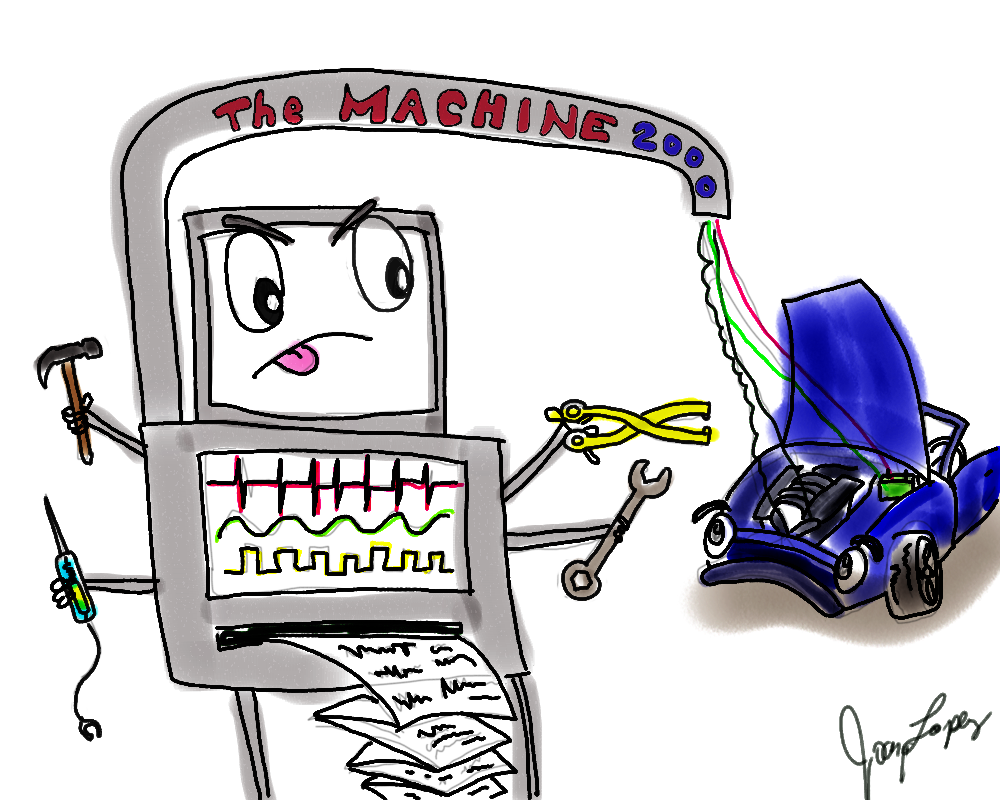What is a diagnosis, anyway?
According to the Marrium-Webster dictionary, a diagnosis is an investigation or analysis of the cause or nature of a condition, situation, or problem. In other words, the act of figuring something out.
Many people believe that a diagnosis is connecting a special computer to their car that can tell the technician all that is wrong. From leaking water pumps to the abs warning lamp, nothing escapes the all knowing diagnostic machine. Truth be told, there is no such machine. No matter what is portrayed on tv or advertisements, there is no instantaneous way for a technician to diagnose a vehicle problem without some testing.
So what about when your “check engine” light comes on and the friendly guy at the parts store tells you that you’ll need new spark plugs because he connected a scanner to your car and read a p0300 code? Isn’t that a diagnosis?
The short answer is no. It is only the beginning of the diagnostic process. In the example above the first step would be to connect a scan tool in order to determine what specific error your car’s computer logged. Usually, the next step would be to monitor the live data that is sent to the computer from your car’s various sensors in order to determining what specific part or events caused the p0300 (random engine misfire) error code. Why does your car’s computer think your engine is misfiring? Is it really misfiring? If it is, are all cylinders affected or is it just one? Do you need spark plugs, spark plug wires, injectors, a vacuum hose, a whole new engine? These are questions that only a trained technician can answer. Not only will he determine what the problem is, he will also determine what the problem is not. After the technician gathers data, he’ll then form a hypothesis as to what he thinks the cause could be and then performs very specific tests on a specific component. If the results don’t lead to a specific failed part, the hypothesis-testing continues until the failed component is found. After the technician is confident he’s found the failed component, the part will be replaced and more testing will be performed to assure that the part and the system the part belongs to, is performing correctly. Additionally, a technician will know what consequential damage may have occurred. In our example, if your engine was indeed misfiring, the technician would know to check for damage to your catalytic converter due to excessive fuel going down the exhaust. After all, you don’t want to leave the shop thinking your “check engine” problem is fixed only to have the light come back on the next day due to a failed catalytic converter.
Clearly, all this testing takes valuable time and all shops will charge for this. Be leery of any repair shops that say they do not charge for diagnostics. Believe me, you will be charged whether you realize it or not.
Having said that though, not every repair will require a diagnosis. The repair shop should inform you when a diagnosis will be required, but as a general rule of thumb, a diagnosis is needed when a problem and solution is not clearly evident. A service engine light, a no start condition, non functioning wipers, engine not producing sufficient power, non functioning abs, engine misfires, and a magnitude of other conditions will require a diagnosis. Many mechanical problems will not require a diagnosis. For example, if your brakes are are making a grinding noise it’s evident that you’ll at least need brake pads. Now, if your pads are worn unevenly, well…


Leave a comment